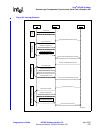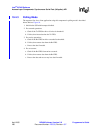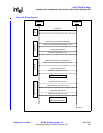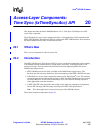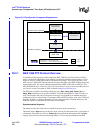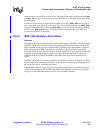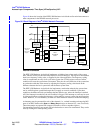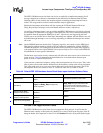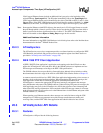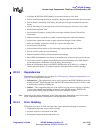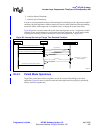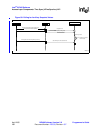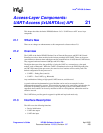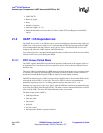
Intel
®
IXP400 Software
Access-Layer Components: Time Sync (IxTimeSyncAcc) API
Programmer’s Guide IXP400 Software Version 2.0 April 2005
Document Number: 252539, Revision: 007 287
The IEEE 1588 Hardware Assist block can also be set explicitly to handle timestamping for all
messages detected on a channel, as determined by the detection of an Ethernet Start of Frame
Delimiter (SFD). In this scenario, the snapshot registers containing the timestamps will not be
locked. This usage model is useful for network traffic analysis applications.
Besides the timestamps, the hardware will also capture the UUID and Sequence ID for the
Delay_Req and Sync messages received in Master and Slaves modes, respectively.
An auxiliary timestamp feature is also provided in the IEEE 1588 Hardware Assist block, allowing
for the capture of system time to be trigger via the GPIO pins. The slave or master timestamp will
be captured when the appropriate GPIO pins (8 and 7, respectively) are triggered by the Intel
XScale core or an external device. When these timestamps are captured, the Intel XScale core will
be notified through interrupts or sets event flags, depending on whether the interrupts are masked
off or not.
Note: On the IXDP465 platform, the Auxiliary Timestamp signal for slave mode is tied to GPIO pin 8.
This signal is software routed by default to PCI for backwards compatibility with the IXDP425 /
IXCDP1100 platform. This routing must be disabled for the auxiliary slave time stamp register to
work properly. Refer to the Intel
®
IXDP465 Development Platform User’s Guide or the BSP/LSP
documentation for more specific information.
The hardware assist can be reset by software and will reflect the same state as can be observed on
power-on reset. Table 49 summarizes the default behavior of certain hardware features upon
power-on reset or software-initiated reset.
Upon reset, the system time, frequency scaling value and target time are all set to zero. Thus, at the
time of power-on reset and software-initiated reset, the frequency scaling value will not increment.
This value needs to be set to a non-zero value to allow the system time to increment. The UUID
and Sequence ID are also cleared to zeros. A UUID with value zero is treated as invalid.
IPv6 and VLAN-Tagged Ethernet Frames
The IEEE 1588 Hardware Assist block does not support the IPv6 protocol. It verifies that the
Ethernet frame contains an IPv4 packet by checking for a value of 0x45 in the first byte of the IP
datagram header. 0x45 represents a value of 4 in the
Version field and a 20-byte IP header length.
Table 49. Default IEEE 1588 Hardware Assist Block States upon Hardware/Software Reset
Hardware Feature Options Default State
Channel Mode
- Master
- Slave
Each channel operates in slave mode.
TimeStamp
- Sync and Delay_Req messages only
- All IPv4 packets
Timestamp is taken for valid
Sync and
Delay_Req messages and locked in the
receive and transmit snapshot registers,
respectively, since the default channel mode
of operation is slave.
Auxiliary Master Mode
Snapshot Interrupt Mask
- Enabled
- Disabled
Disabled
Auxiliary Slave Mode
Snapshot Interrupt Mask
- Enabled
- Disabled
Disabled
Target Time Interrupt Mask
- Enabled
- Disabled
Disabled



